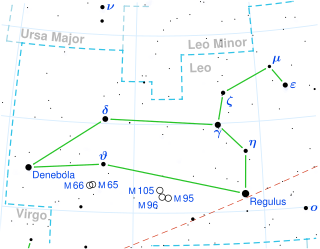
Regulus is the brightest object in the constellation Leo and one of the brightest stars in the night sky. It has the Bayer designation designated α Leonis, which is Latinized to Alpha Leonis, and abbreviated Alpha Leo or α Leo. Regulus appears singular, but is actually a quadruple star system composed of four stars that are organized into two pairs. The spectroscopic binary Regulus A consists of a blue-white main-sequence star and its companion, which has not yet been directly observed, but is probably a white dwarf. The system lies approximately 79 light years from the Sun.

An occultation is an event that occurs when one object is hidden from the observer by another object that passes between them. The term is often used in astronomy, but can also refer to any situation in which an object in the foreground blocks from view (occults) an object in the background. In this general sense, occultation applies to the visual scene observed from low-flying aircraft when foreground objects obscure distant objects dynamically, as the scene changes over time.
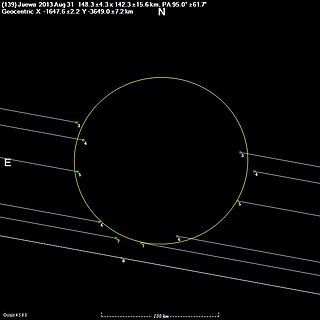
139 Juewa is a very large and dark main belt asteroid. It is probably composed of primitive carbonaceous material. It was the first asteroid discovered from China.
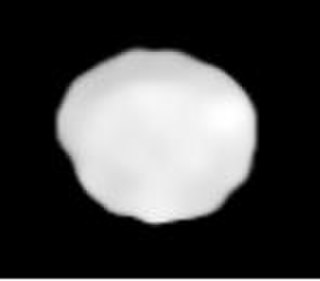
Fortuna is one of the largest main-belt asteroids. It has a composition similar to 1 Ceres: a darkly colored surface that is heavily space-weathered with the composition of primitive organic compounds, including tholins.

Diana is a large and dark main-belt asteroid. It was discovered by German astronomer Robert Luther on March 15, 1863, and named after Diana, Roman goddess of the hunt. The asteroid is orbiting the Sun at a distance of 2.620 AU with a period of 4.24 years and an eccentricity (ovalness) of 0.207. The orbital plane is tilted at an angle of 8.688° relative to the plane of the ecliptic. Its composition is carbonaceous and primitive.
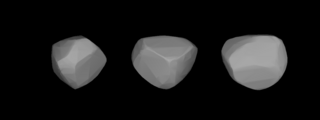
Ianthe is a large main-belt asteroid, named for three figures in Greek mythology. It is very dark and is composed of carbonates. It was one of the numerous discoveries by C. H. F. Peters, who found it on April 18, 1868, from Clinton, New York.

Ate is a main-belt asteroid discovered by the German-American astronomer C. H. F. Peters on August 14, 1870, and named after Ate, the goddess of mischief and destruction in Greek mythology. In the Tholen classification system, it is categorized as a carbonaceous C-type asteroid, while the Bus asteroid taxonomy system lists it as an Ch asteroid.

Lachesis is a large main-belt asteroid. It was discovered by French astronomer Alphonse Borrelly on April 10, 1872, and independently by German-American astronomer Christian Heinrich Friedrich Peters on April 11, 1872, then named after Lachesis, one of the Moirai, or Fates, in Greek mythology. A Lachesean occultation of a star occurred in 1999 and was confirmed visually by five observers and once photoelectrically, with the chords yielding an estimated elliptical cross-section of 184 × 144 km.

Sophrosyne is a large main-belt asteroid that was discovered by German astronomer Robert Luther on 27 September 1873, and was named after the concept of sophrosyne, Plato's term for 'moderation'. Classified as a C-type asteroid, it has an exceedingly dark surface and most probably a primitive carbonaceous composition.
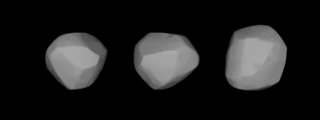
Lucina is a main-belt asteroid that was discovered by Alphonse Borrelly on June 8, 1875, and named after Lucina, the Roman goddess of childbirth. It is large, dark and has a carbonaceous composition. The spectra of the asteroid displays evidence of aqueous alteration.

161 Athor is an M-type Main belt asteroid that was discovered by James Craig Watson on April 19, 1876, at the Detroit Observatory and named after Hathor, an Egyptian fertility goddess. It is the namesake of a proposed Athor asteroid family, estimated to be ~3 billion years old.
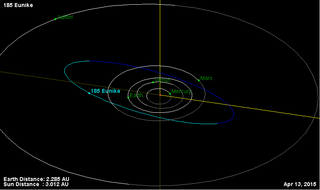
Eunike is a dark and very large main-belt asteroid, with an approximate diameter of 157 kilometres. It has a primitive carbonaceous composition.

Dynamene is a large dark main-belt asteroid that was discovered by German-American astronomer Christian Heinrich Friedrich Peters on July 27, 1879, in Clinton, New York. The name derives from Dynamene, one of the fifty Nereids in Greek mythology. Based upon its spectrum, 200 Dynamene is classified as a C-type asteroid, indicating that it probably has a primitive composition similar to the carbonaceous chondrite meteorites. The spectra of the asteroid displays evidence of aqueous alteration.
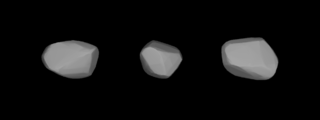
Amherstia was the 8th asteroid discovered by Raymond Smith Dugan, and was named after Amherst College, his alma mater. Amherstia is a large M-type main belt asteroid, with an estimated diameter of 73 km. It follows an eccentric orbit between Jupiter and Mars, with an orbital period of 4.39 years. The orbital plane is inclined at an angle of 13° to the ecliptic.
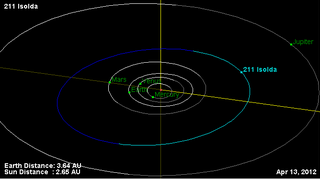
Isolda is a very large, dark main-belt asteroid. It is classified as a C-type asteroid and is probably composed of primitive carbonaceous material. The spectra of the asteroid displays evidence of aqueous alteration.
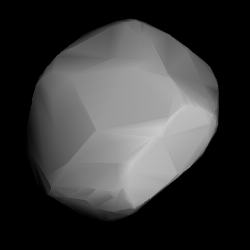
Hypatia is a very large main-belt asteroid that was discovered by Russian astronomer Viktor Knorre on July 1, 1884, in Berlin. It was the third of his four asteroid discoveries. The name was given in honour of philosopher Hypatia of Alexandria. Based upon the spectrum, it is classified as a C-type asteroid and is probably composed of primitive carbonaceous material. Like many asteroids of this type, its surface is very dark in colour.
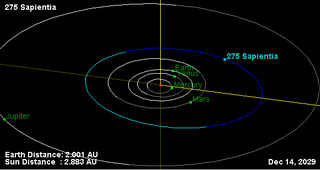
Sapientia is a very large Main belt asteroid that was discovered by Johann Palisa on 15 April 1888 in Vienna. It is classified as a C-type asteroid and is probably composed of carbonaceous material. It is named for the Roman personification of wisdom, Sapientia.
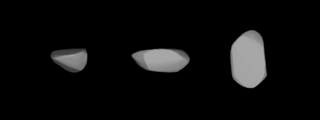
Clarissa is a typical main belt asteroid. The asteroid was discovered by the French astronomer Auguste Charlois on 14 November 1890 in Nice. The origin of the name is unknown. In 1991, 302 Clarissa was being considered as a possible fly-by target for the Cassini spacecraft, but was later removed from consideration.
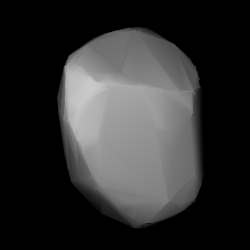
Gudrun is a main-belt asteroid.

SOLEX is a free computer application that calculates and displays the positions and dynamics of bodies that are part of the Solar System. It was developed by Aldo Vitagliano, a professor of inorganic chemistry at the Federico II University of Naples.
























